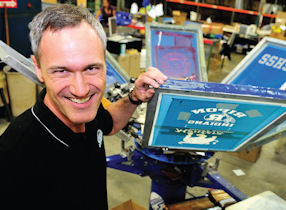Organized SportsWear, a Chatsworth company that is one of the largest suppliers of school gym uniforms in the western United States, has been bought by an area private equity firm in its first acquisition. CriticalPoint Capital, in El Segundo, closed on its deal with Rick and Karen Johnson, founders of Organized SportsWear, at the end of September. Financial terms of the deal were not disclosed. “We had gotten to the point where we were looking at (financial) security and not willing to take risks,” said Karen Johnson, who had been president and remains special assistant to new president, Rick Bolander. Rick Johnson, who turned 72 this year, has left the business. Organized SportWear, started 25 years ago, has grown into a $10 million business serving the western states with 85 percent of its orders going to California public and private schools. The California P.E. uniform market totals some $35 million to $45 million in annual sales and is highly competitive. Rivals include Coastal Enterprises in Fountain Valley; My School Things in Cerritos; and One Stone Apparel in Lomita. Prior to the recession, annual growth of 10 percent was standard at Organized. And it’s a goal of CriticalPoint’s ownership to get the company back on that trajectory, said Matt Young, who is chief executive of Critical Point, which he founded a year ago. Among the initiatives to achieve that growth will be refreshing the company’s product offering and leveling out some of the seasonality to the business. Organized SportsWear’s busiest time extends from April to September. During those months, its production area is jam-packed shipping out 10,000 to 12,000 shirts, shorts and pants per day. “You are going to have … to provide other products, whether its spirit wear or selling to clubs and groups,” Young said. “That is part of the strategy we are trying to implement.” Karen Johnson said she and her husband did not deal with the issue of seasonality, but agreed it needed to be addressed. Young said the firm has a major asset –strong customer loyalty. Maria Cross, who handles the purchasing of P.E. uniforms and other clothing items at Lynwood High School in Lynwood, recalled how at Christmastime, Rick Johnson would stop by the school and ask about what types of clothing would be needed for the following school year. “Sometimes you just hear a voice over the phone, so for someone to take the time and stop by your office was very nice,” Cross said. She also likes the fact she can feel the company’s material to see if it can stand up to multiple washings, which is not possible when ordering from more distant vendors. “I’ve been disappointed when ordering from a catalogue,” she said. Buyout The couple worked on the sale with Mentor Group, a Westlake Village investment banking, financial advisory and appraisal firm, starting in summer 2012. Initially, there were 40 companies contacted regarding the sale of Organized SportsWear. Out of that number about a half dozen were serious about closing the deal, said Justin Blaine, a managing director with Mentor Group. “It came down to a few groups,” Blaine said. “Some were uniform companies without a (physical education) presence or others just involved with private schools.” The company had characteristics that CriticalPoint sought, such as being a market leader in a niche market, stable revenue and a diverse customer base. “You had confidence that if you lost a customer it was not going to crush the business,” Young said. Supplying to schools also is a stable business model because once a school chooses its colors, it likely is never going to change them, said Bolander, who previously worked for telecom giant AT&T Inc. and in the finance and budget office of Los Angeles Air Force Base in El Segundo. Schools order from Organized wholesale and they may or may not mark up the products, which this year range from as low as $8.65 for gym shirts and tops to as much as $11 for the same combo with performance material. “It’s up to the school whether or not they sell to the students at cost or use it as a fundraising opportunity, although most tend to do the latter if for nothing other than to potentially subsidize P.E. uniforms for economically challenged students,” Bolander said. Making the school apparel business challenging is that school budgets have gotten tighter, which puts price pressure on the clothing they buy. At the same time, students want to wear items that are fashion forward, Young said. Among items that today’s pre-teens and teens seek are tagless shirts, yoga outfits and material made with moisture-absorbing fabric, such as Nike’s Dry-FIT. That was an area that Organized didn’t excel in. “The way we look at it, what we bring is energy and enthusiasm to reach out and broaden the offerings,” Bolander said. The company also is looking into offering a competitively priced entry-level clothing line, and to move all its inventory. Young said the company will hire five to six new people in the sales and marketing department. Organized SportsWear uses multiple suppliers for its materials. Once the materials arrive at the Chatsworth facility, workers screen print school names, logos and mascots on them using both seven-armed automated machinery, and the smaller hand-operated equipment. After that, the clothing is put through a giant dry oven, that sets the ink. The production area is bisected by tall cabinets storing the screens used to place the graphics on the clothing. There are about 6,000 screens, Bolander estimated. “The screen inventory is a visual representation of the loyal customer base (the company developed) over the years,” he added.
